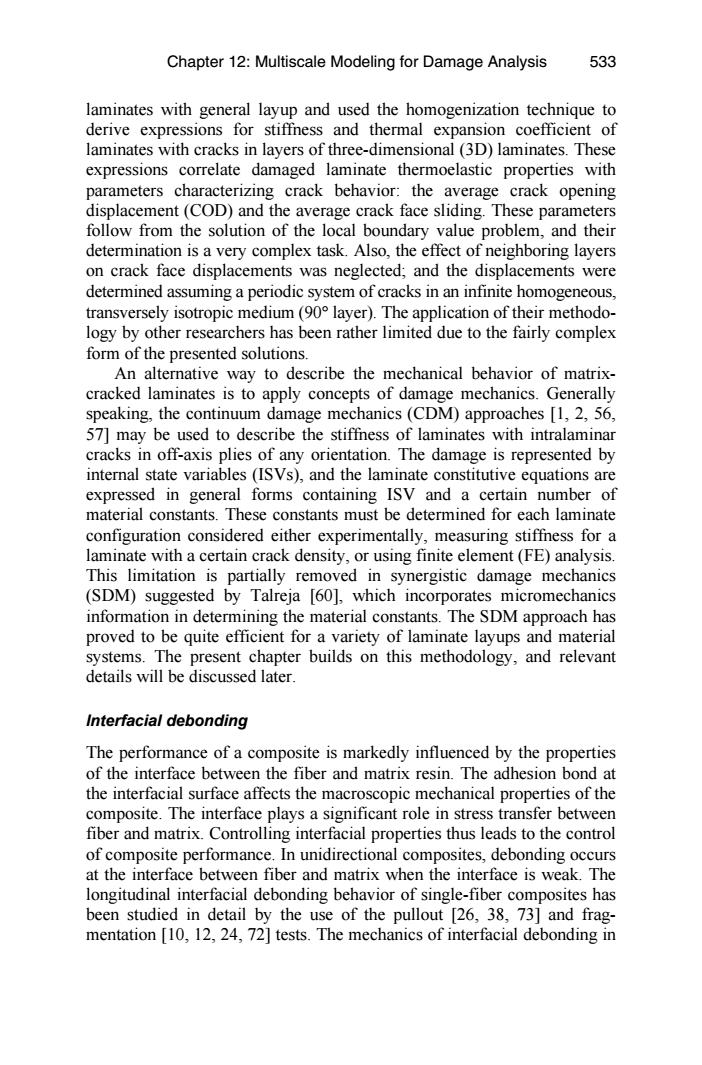正在加载图片...

Chapter 12:Multiscale Modeling for Damage Analysis 533 laminates with general layup and used the homogenization technique to derive expressions for stiffness and thermal expansion coefficient of laminates with cracks in layers of three-dimensional(3D)laminates.These expressions correlate damaged laminate thermoelastic properties with parameters characterizing crack behavior:the average crack opening displacement (COD)and the average crack face sliding.These parameters follow from the solution of the local boundary value problem,and their determination is a very complex task.Also,the effect of neighboring layers on crack face displacements was neglected;and the displacements were determined assuming a periodic system of cracks in an infinite homogeneous, transversely isotropic medium(90 layer).The application of their methodo- logy by other researchers has been rather limited due to the fairly complex form of the presented solutions. An alternative way to describe the mechanical behavior of matrix- cracked laminates is to apply concepts of damage mechanics.Generally speaking,the continuum damage mechanics(CDM)approaches [1,2,56, 57]may be used to describe the stiffness of laminates with intralaminar cracks in off-axis plies of any orientation.The damage is represented by internal state variables (ISVs),and the laminate constitutive equations are expressed in general forms containing ISV and a certain number of material constants.These constants must be determined for each laminate configuration considered either experimentally,measuring stiffness for a laminate with a certain crack density,or using finite element(FE)analysis. This limitation is partially removed in synergistic damage mechanics (SDM)suggested by Talreja [60],which incorporates micromechanics information in determining the material constants.The SDM approach has proved to be quite efficient for a variety of laminate layups and material systems.The present chapter builds on this methodology,and relevant details will be discussed later. Interfacial debonding The performance of a composite is markedly influenced by the properties of the interface between the fiber and matrix resin.The adhesion bond at the interfacial surface affects the macroscopic mechanical properties of the composite.The interface plays a significant role in stress transfer between fiber and matrix.Controlling interfacial properties thus leads to the control of composite performance.In unidirectional composites,debonding occurs at the interface between fiber and matrix when the interface is weak.The longitudinal interfacial debonding behavior of single-fiber composites has been studied in detail by the use of the pullout [26,38,73]and frag- mentation [10,12,24,72]tests.The mechanics of interfacial debonding inlaminates with general layup and used the homogenization technique to derive expressions for stiffness and thermal expansion coefficient of laminates with cracks in layers of three-dimensional (3D) laminates. These expressions correlate damaged laminate thermoelastic properties with parameters characterizing crack behavior: the average crack opening displacement (COD) and the average crack face sliding. These parameters follow from the solution of the local boundary value problem, and their determination is a very complex task. Also, the effect of neighboring layers on crack face displacements was neglected; and the displacements were determined assuming a periodic system of cracks in an infinite homogeneous, transversely isotropic medium (90° layer). The application of their methodology by other researchers has been rather limited due to the fairly complex form of the presented solutions. An alternative way to describe the mechanical behavior of matrixcracked laminates is to apply concepts of damage mechanics. Generally speaking, the continuum damage mechanics (CDM) approaches [1, 2, 56, 57] may be used to describe the stiffness of laminates with intralaminar cracks in off-axis plies of any orientation. The damage is represented by internal state variables (ISVs), and the laminate constitutive equations are expressed in general forms containing ISV and a certain number of material constants. These constants must be determined for each laminate configuration considered either experimentally, measuring stiffness for a laminate with a certain crack density, or using finite element (FE) analysis. This limitation is partially removed in synergistic damage mechanics (SDM) suggested by Talreja [60], which incorporates micromechanics information in determining the material constants. The SDM approach has proved to be quite efficient for a variety of laminate layups and material systems. The present chapter builds on this methodology, and relevant details will be discussed later. Interfacial debonding The performance of a composite is markedly influenced by the properties of the interface between the fiber and matrix resin. The adhesion bond at the interfacial surface affects the macroscopic mechanical properties of the composite. The interface plays a significant role in stress transfer between fiber and matrix. Controlling interfacial properties thus leads to the control of composite performance. In unidirectional composites, debonding occurs at the interface between fiber and matrix when the interface is weak. The longitudinal interfacial debonding behavior of single-fiber composites has been studied in detail by the use of the pullout [26, 38, 73] and fragmentation [10, 12, 24, 72] tests. The mechanics of interfacial debonding in Chapter 12: Multiscale Modeling for Damage Analysis 533